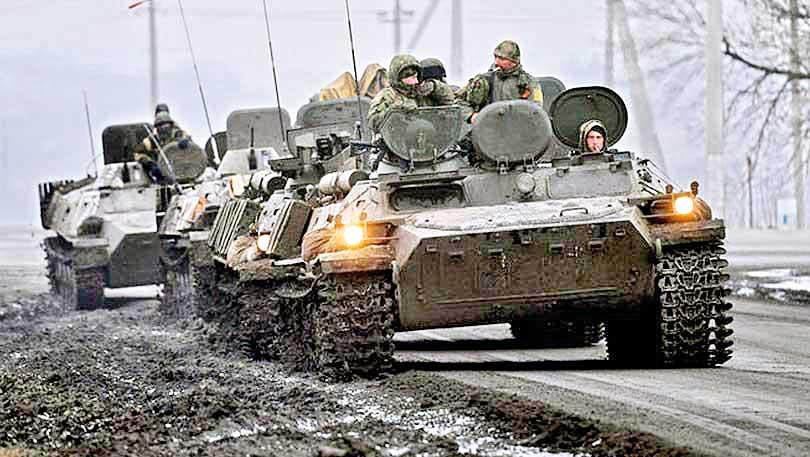17 Sep 2024 - {{hitsCtrl.values.hits}}

There seems to be no end in sight to the war in Ukraine two years after the Russian invasion.
Russian President Vladimir Putin has signalled he’s ready for a peace deal, but entirely on his terms
Lt. Col. Mes was a highly experienced pilot and received extended training to fly the F-16
 Everyone wants to see an end to the war in Ukraine – everyone except the combattants. There is no end in sight to the war two years after the Russian invasion. The war isn’t limited to Ukraine – since President Volodymyr Zelenskyy gambled on a surprise counterattack in Kursk, it has spilled over to Russian territory.
Everyone wants to see an end to the war in Ukraine – everyone except the combattants. There is no end in sight to the war two years after the Russian invasion. The war isn’t limited to Ukraine – since President Volodymyr Zelenskyy gambled on a surprise counterattack in Kursk, it has spilled over to Russian territory.
Both sides have been so aggressive militarily this year that you wonder whether either Kyiv or Moscow really wants peace. As Klausewitz noted during an earlier era of European wars, ‘war is politics by other means.’
Russian President Vladimir Putin has signalled he’s ready for a peace deal, but entirely on his terms, which are quite unacceptable to Ukraine’s current leadership.
It’s very hard to get a clear picture going by social media podcasts and reports of what’s happened militarily over the past few months after the Russian army began closing in on the key eastern Ukrainian city of Pokhrovsk, and Ukraine sent its army into Russian territory on Aug. 16.
Social media propaganda
There is a social media propaganda war which is, if anything, even more fierce than the actual combat, with both sides claiming victory. But there are a few independent analysts, such as Prof. John Mearsheimer of Chicago University, and retired American colonel Douglas Macgregor (author, consultant, and political commentator) who have been saying for months that Ukraine is losing this war and should negotiate a peace while it still can.
But there is also the view that Ukraine is merely a proxy in a bigger conflict between the West (US and NATO) and Russia, with NATO expanding aggressively towards Russia’s borders. From the NATO point of view, this is necessary to stop Russian expansion towards the West. Which point of view you believe depends on which side you take.
But what is clear to any neutral observer is that this is a war that could escalate dangerously into a nuclear conflict. When French President Emmanuel Macron said French soldiers could be deployed to help the Ukrainians, President Putin reminded him of Russia’s nuclear power. If necessary, he won’t hesitate to use it.
While both sides claim victory, it’s clear that the ground war isn’t moving as swiftly as claimed. The Russians are close to Pokhrovsk but haven’t taken it yet. The Ukrainians still hold some Russian territory in the Kursk salient, but they failed to reach their goal, the Kursk nuclear power plant.
F 16
NATO promised to give Ukraine 65 of its US-made F16 interceptors. It took a long time, but an unspecified number finally got there, making President Zelensky brag a few weeks ago: “The F-16s are here. We did it.”
The feared, high tech machines were expected to do miracles for Ukraine’s outnumbered and overworked air force, still dependent on its Russian made MiG and Sukhoi aircraft.
Instead, one crashed late in August, killing its experienced pilot Lt. Col. Oleksiy Mes. President Zelensky reacted by looking for a scapegoat. He found one – Ukraine’s air force Chief Lt Gen Mykola Oleshchuk – and fired him ten days after the crash.
There is an official investigation going on, but critics say it looks more like a cover up. Speculation has surrounded the cause of the crash after Mariana Bezugla, a Ukrainian politician sitting on the country’s parliamentary defense committee, said the F-16 had fallen victim to friendly fire from a Patriot air defense system.
The official version is that the F-16 flown by Lt. Col. Mes was engaged in intercepting Russian cruise missiles when his aircraft went off the radar. It says he had already destroyed two missiles and was attacking a third when this happened.
There is no evidence that it was shot down by Russian fighters or SAM missiles. One objective military analyst offers the following explanation, which seems quite plausible to me.
The F-16s given to Ukraine are said to be fourth generation aircraft, but they are quite old. As one commentator puts it: “NATO no longer wants to fly them.’
Also, these F-16s were configured for air to air interception. Ground attack isn’t their profile. This may sound ideal from the Ukrainian point of view, as they badly need to wrest air superiority from Russia. But Lt. Col. Mes’ F16 was lost while chasing missiles, not other aircraft, and that’s worth considering.
To evade missiles, whether fired from the ground or from another aircraft, an interceptor must go into complicated S manoeuvers which exert tremendous G forces on both pilot and aircraft. This is nothing new – it’s as old as the Vietnam war, when MiG21 fighters engaged in such manouevers to evade Sidewinder missiles fired by American Phantoms.
But there is no evidence a Russian fighter engaged the lost F-16. The Ukrainian air force says it was attacking Russian cruise missiles, which aren’t designed to shoot down aircraft. Nor is there any evidence that the Russians brought it down with a SAM missile.
‘Friendly fire’ angle
That brings in the ‘friendly fire’ angle, that the F-16 was lost while trying to evade a Patriot anti-aircraft missile mistakenly fired at it by Ukrainian air defences.
There is no evidence that the F-16 was hit by a Patriot. On the other hand, if it was trying to evade one by going into a rapid and difficult manouver, its ageing frame may have disintegrated under resulting stresses.
Military analysts say they have audio recordings of Russian MiG and Sukhoi pilots grunting as they try to evade Ukrainian SAM missiles. This is due to the tremendous G forces exerted. But their MiG-29s and Sukhoi SU-37s are newer than these NATO-supplied F-16s and can withstand the stress.
Lt. Col. Mes was a highly experienced pilot and received extended training to fly the F-16. But he has years of experience flying Russian fighters, and muscle memory may have instinctively prompted him to do what he used to do when flying those much newer aircraft. He wouldn’t have known if the older F-16 could handle the same stress load.
The explanation may lie elsewhere, but this theory looks plausible in the absence of something better.
It simply means that Ukrainian pilots would be more nervous from now on flying combat missions in their NATO-supplied wonder weapons. That doesn’t make for good air warfare.
22 Dec 2024 3 hours ago
22 Dec 2024 3 hours ago
22 Dec 2024 5 hours ago
22 Dec 2024 6 hours ago
22 Dec 2024 6 hours ago